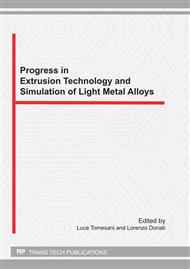[1]
R. Akeret: Die Produktivität beim Strangpressen von Aluminium-Werkstoffen – Einfluss von Werkstoff und Verfahren, Zeitschrift für Metallkunde, Vol. 62 (1971) 6, pp.451-456.
DOI: 10.1515/ijmr-1971-620601
Google Scholar
[2]
A.K. Das: Special Features of Process Defects in Aluminium Alloy Extrusions, Proceedings of the Fourth Int. Extrusion Technology Seminar, April 11-14, Chicago, 1988, Vol. 2, pp.227-233.
Google Scholar
[3]
O. Lohne: Simulation of Hot Tearing of Aluminium Alloys, Proceedings of the Fourth Int. Extrusion Technology Seminar, April 11-14, Chicago, 1988, Vol. 2, pp.303-308.
Google Scholar
[4]
A.K. Biswas, B. Repgen: Isothermal and Isopressure Extrusion Results of Process Optimization in Various Extusion Plants, Proceedings of the Sixth Int. Aluminum Extrusion Technology Seminar, Chicago, Illinois, 1996, pp.37-43.
Google Scholar
[5]
P.K. Saha: Aluminum Extrusion Technology, ASM Int., Materials Par, OH, 2000, pp.45-51.
Google Scholar
[6]
J.C. Benedyk: The Evolution of the Smart Container: Achieving Isothermal Control in Extrusion, Light Metal Age, August 2008, pp.40-47.
Google Scholar
[7]
R. Akeret: Das Verhalten der Strangpresse als Regelstrecke, Metall, 34 (1980) 8, pp.737-741.
Google Scholar
[8]
M. Bauser, G. Sauer, K. Siegert: Strangpressen, Aluminium-Verlag, Düsseldorf, (2001).
Google Scholar
[9]
R.J. Selines, F.D. Lauricella: Extrusion Cooling and Inerting Using Liquid Nitrogen, Proc. of the Third Int. Al. Extrusion Techn. Seminar, April 24-26, Atlanta, Georgia, 1984, pp.221-226.
Google Scholar
[10]
T.J. Ward, J.F. Heffron: The Effects of Nitrogen and Liquid and Gaseous on Aluminum Extrusion Productivity, Proceedings of the Third Int. Aluminum Extrusion Technology Seminar, April 24-26, Atlanta, Georgia, 1984, pp.211-219.
DOI: 10.1007/bf03339208
Google Scholar
[11]
H. Yamaguchi: Increase in Extrusion Speed and Effects on Hot Cracks and Metallurgical Structure of Hard Aluminium Extrusions, Proceedings of the Fifth Int. Aluminum Extrusion Technology Seminar, Chicago, 1992, pp.447-453.
Google Scholar
[12]
Perfectionnement au filage à chaud des métaux, French Patent, FR 980 781, (1953).
Google Scholar
[13]
M. Rossmann, R. Strigl: Verfahren zum Strangpressen bzw. Strangziehen, European Patent, EU 0 210 568 B1, (1994).
Google Scholar
[14]
J. Busse, U. Thorwarth: INCAL – Höhere Produktivität beim Strangpressen von Aluminium Halbzeugen, Firmenschrift Messer Schweiz AG, Lenzburg, Schweiz, (2002).
Google Scholar
[15]
M. Fortier, D. Lavoie, N. Parson, C. Jowett: The Use of Gaseous Nitrogen to Improve the Surface Finish of Dilute 6xxx Extrusions, Proceedings of the Ninth Int. Aluminum Extrusion Technology Seminar, 13-16 Mai, Orlando, Florida, (2008).
Google Scholar
[16]
G. Scharf: Ein Beitrag zum Strangpressen mit gekühltem Werkzeug, Aluminium, Vol. 55 (1979) 3, pp.197-201.
Google Scholar
[17]
W. Kortmann: Technologie der Strangpresswerkzeuge, S+C Märker GmbH, Lindlar, (2004).
Google Scholar
[18]
R.J. Fiorentino, E.G. Jr. Smith: Rapid Extrusion of Hot-short-sensitive Alloys, US Patent 462234, (1984).
Google Scholar
[19]
R.J. Fiorentino, E.G. Jr. Smith: Improved Cooled Dies for Increasing Aluminum Extrusion Productivity, Proceedings of the Fourth Int. Extrusion Technology Seminar, April 11-14, Chicago, 1988, Vol. 2, pp.79-82.
Google Scholar
[20]
A. Gebhardt: Generative Fertigungsverfahren: Rapid Prototyping - Rapid Tooling - Rapid Manufacturing, Carl Hanser Verlag, München (2007).
DOI: 10.3139/9783446436527.005
Google Scholar
[21]
G. Hoffmann: LaserCusing® - Neue innovative Möglichkeiten der Werkzeugtemperierung, Anwendungen und Beispiele aus der Praxis, In: Zäh, M.; Reinhart, G.: IWB Seminarberichte 85, 3-D Erfahrungsforum Innovation im Werkzeug und Formenbau, München, 30. -31. 05. 2007, pp.9-1.
DOI: 10.1002/9783527624225.ch25
Google Scholar
[22]
W.Z. Misiolek, K.T. Winther, A.E. Prats, S.J. Rock: Rapid Prototyping of Extrusion Dies Using Layer-Based Techniques, J. of Materials Eng. and Performance, 8 (1999) 1, pp.23-30.
DOI: 10.1361/105994999770347124
Google Scholar
[23]
B. ÓDonnchadha, A. Tansey: A note on rapid metal composite tooling by selective laser sintering, Journal of Materials Processing Technology, Vol. 153-154 (2004), pp.28-34.
DOI: 10.1016/j.jmatprotec.2004.04.034
Google Scholar


